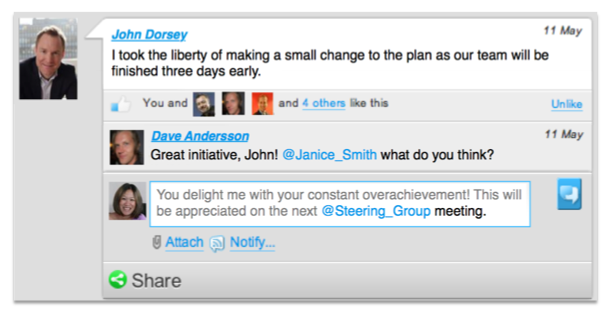
In his July 2009 TED talk, New York Times and Wall Street Journal bestselling author Dan Pink talks about intrinsic motivation: “The three most vital components of a successful project: autonomy, mastery and meaning”. Do go ahead and listen to the seventeen minute presentation, it’s well worth it. Then, read on.
I would argue that successful projects, just as successful companies, effectively combat pitfalls that stem from a lack of “autonomy, mastery and meaning” among employees and other project members.
So let’s start by addressing “meaning” in the typical project setting (if there ever was such a thing) and then touch on the subject of how a web-based service such as ProjectPlace could possibly help a project team understand and reflect on the meaning of a project.
Understanding the purpose of a project, as well as project goals, is an intrinsic motivator for most of us that spend a lot of our time working in them. But often the purpose of a project and its goals are in fact not entirely clear to everyone involved. Sometimes the project management fails to communicate these to the rest of the team, sometimes project constituents fall through when explaining them to the project management (whose responsibility it then is to continue asking the right questions). In my own experience, an alarming portion of projects go ahead without a clear understanding of what should be achieved, and more importantly, why. In order for project goals to be understood, they have to be effectively communicated.
I am not talking about low-level implementation details here, I’m referring to the overall expected project deliverables, the expected outcome of a project – indeed, the reasons we are doing it.
What does this imply?
The most important job for the project manager is not to draw Gantt charts, it is to communicate the purpose of the project to the team and to lead the team towards the goals by supporting the team in various ways.
Currently at Projectplace, we are hard at work on the next generation of tools aimed at assisting in communicating the project goals. We think we will soon have a pretty unique approach available for our customers. Let me give you a few examples.
Firstly, an effective way of communicating the meaning of a project can be through some sort of “tagline” or succinct phrase that can work to remind project members of why they are there. “Social Planning: From Goal to Action” is one such phrase that we currently use in the ongoing project of modernising the planning support in Projectplace. What if your project collaboration tool of choice included an attractive and foolproof-simple way of publishing your project’s tagline for everyone to be reminded of on a daily basis?
Secondly, a lot of the time it is reasonably well known at the start of a project what the main deliverables, tollgates and other important deadlines are during a project’s lifetime. These make up what we call the Master Plan. In fact, steps along the timeline of the project express a lot of the meaning of the project. What if the project’s steps and timeline were brought to the forefront and always reflected the current status?
Thirdly, plans are always hypotheses and as such they require constant re-evaluation, retrospective and re-planning. This is a major cornerstone of Social Project Management. What if changes to the Master Plan were easily communicated to project members in a way that promote team engagement in the project’s changing goals?
These were a few examples of work underway at ProjectPlace aimed at helping a project team understand and reflect on the meaning of a project. Future blog posts will add perspectives of how Dan Pink’s remaining intrinsic motivators autonomy and mastery might be supported in future ProjectPlace offerings.





